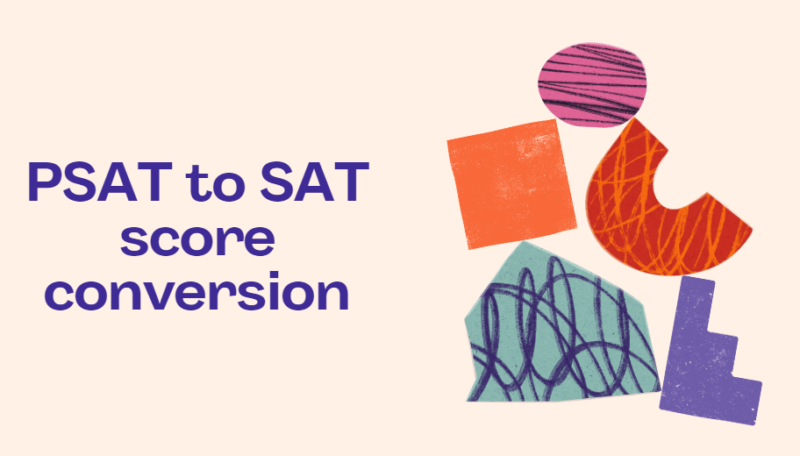Navigating the maze of standardized testing can be daunting. Yet, understanding how scores from different tests compare can illuminate your path to college admissions. By demystifying the ACT to PSAT conversion, this article serves as a beacon for students navigating the complex terrain of standardized testing. Such milestones mark the journey through high school to college, and understanding how different test scores relate can significantly ease the path to your academic goals. With this knowledge, students can approach their preparation with clarity and confidence, ensuring they are well-equipped for the challenges ahead.
ACT vs. PSAT Conversion Table
In one of our previous articles, ACT vs. SAT, we have mentioned what is the main difference between them. When comparing ACT and PSAT scores, it’s helpful to visualize their relationship through a PSAT to ACT score converter.
| ACT Score |
PSAT Score |
ACT Score |
PSAT Score |
| 09 |
590-610 |
22 |
1100-1120 |
| 10 |
620-640 |
23 |
1130-1150 |
| 11 |
650-680 |
24 |
1160-1190 |
| 12 |
690-720 |
25 |
1200-1220 |
| 13 |
730-770 |
26 |
1230-1250 |
| 14 |
780-820 |
27 |
1260-1290 |
| 15 |
830-870 |
28 |
1300-1320 |
| 16 |
880-910 |
29 |
1330-1350 |
| 17 |
920-950 |
30 |
1360-1380 |
| 18 |
960-980 |
31 |
1390-1410 |
| 19 |
990-1020 |
32 |
1420-1440 |
| 20 |
1030-1050 |
33 |
1450-1480 |
| 21 |
1060-1090 |
34 |
1490-1520a |
For instance, an ACT score of 34 correlates to a PSAT score range of 1490-1520, demonstrating the high caliber of performance across both exams. Conversely, an ACT score of 21 matches a PSAT score of approximately 1060-1090, reflecting a more average performance. This ACT/PSAT conversion can guide students in understanding where they stand across different testing formats and setting realistic expectations for college applications.
What is ACT
The ACT is a standardized test for college admissions in the United States. It assesses a student’s readiness for college through four sections: English, Mathematics, Reading, and Science, with an optional Writing section. The ACT score is a composite of these sections, offering colleges a comprehensive view of an applicant’s academic capabilities. It is recognized nationwide by colleges and universities as a reliable indicator of a student’s academic proficiency and potential for success in a rigorous college environment. Each section of the ACT is scored on a scale of 1 to 36, with the composite score being the average of these four sections.
This holistic approach to assessment allows for a nuanced understanding of a student’s strengths and weaknesses across a broad spectrum of subjects. Furthermore, the optional Writing section, scored separately, provides insight into a student’s ability to articulate and structure complex ideas. If you’re still wondering what a student should bring to the SAT test, read one of our previous articles. Taking the ACT not only aids in the college admissions process but also helps students identify areas for improvement before embarking on higher education. It serves as a critical step for high school students aiming to transition smoothly into college-level academics. To be sure, how long the ACT test is, check the info in our blog.
What is PSAT
The Preliminary SAT, or PSAT, serves as a practice test for the SAT and a qualifying test for the National Merit Scholarship Program. It’s designed to assess the critical reading, math, problem-solving, and writing skills essential for college academic success. The PSAT provides a benchmark for students to gauge their preparation for the SAT and potential college readiness. The College Board administers the PSAT, which is typically taken by high school sophomores and juniors in the fall.
Participating in the PSAT offers students the opportunity to experience the format and pacing of the SAT under real testing conditions, making it an invaluable step in the preparation process. Additionally, scoring well on the PSAT can qualify students for recognition and scholarships through the National Merit Scholarship Program, which can be a significant accolade on college applications. Beyond its role as a preparatory test and scholarship qualifier, the PSAT also provides detailed feedback on performance, identifying specific areas where a student can improve. This feedback is crucial for targeting study efforts effectively in preparation for future SAT attempts.
How is the PSAT Scored?
The PSAT score comprises two main sections: Evidence-Based Reading and Writing (EBRW) and Math, each scored on a scale of 160 to 760, making the total score range from 320 to 1520. Unlike the SAT, the PSAT does not include an essay section. The scoring process for the PSAT also includes a Selection Index, which is used by the National Merit Scholarship Corporation to determine eligibility for their scholarship programs.
This index is calculated by doubling the sum of the Reading, Writing Language, and Math test scores. Additionally, students receive subs cores in areas such as Command of Evidence, Words in Context, and Analysis in History/Social Studies, providing deeper insights into their skills. These subs cores, ranging from 8 to 38, help students and educators understand specific strengths and weaknesses.
What is the difference between the ACT and PSAT?
The main differences between the ACT and PSAT lie in their structure, scoring scales, and purpose. The ACT includes a Science section and an optional Writing test, neither of which is present in the PSAT. Additionally, the ACT is used directly for college admissions, while the PSAT serves as a precursor to the SAT and a scholarship qualifier. Another key difference is the content and difficulty level; the ACT covers more advanced mathematics topics, including trigonometry, and has a unique science reasoning section that tests critical thinking and problem-solving skills in a scientific context.
The PSAT, on the other hand, focuses more on the skills and knowledge at the heart of education without as much emphasis on higher-level math. Moreover, the scoring system of the ACT ranges from 1 to 36 for each section and for the composite score, whereas the PSAT scores each section on a scale of 160 to 760, leading to a different perception of scores by students and educators. The PSAT is also known for its role in the National Merit Scholarship competition, offering high-achieving students a chance at recognition and scholarships, a feature that the ACT does not directly offer.
FAQ
What Does Your PSAT Score Mean for the SAT or ACT?
Understanding your PSAT score is pivotal in planning your preparation for the SAT or ACT. It highlights your strengths and areas for improvement, allowing for targeted study strategies. For those aiming for their PSAT convert to ACT score equivalents, it’s a step towards setting realistic goals and understanding their potential college admission prospects.
Is the PSAT similar to the ACT?
While there are similarities in content areas covered by the PSAT and ACT, the format, scoring, and emphasis of certain skills differ. The PSAT is more aligned with the SAT but can still provide valuable insights into areas of strength and weakness relevant to the ACT. To be sure how to prepare, read our previous article about the best prep courses.
How does PSAT score compare to ACT?
A high PSAT score suggests a strong foundation that could translate into a competitive ACT score with appropriate preparation. However, because the scoring scales differ, direct comparisons should be used as a general guide rather than a precise predictor. Now, it should be easier for you to convert PSAT to ACT.



